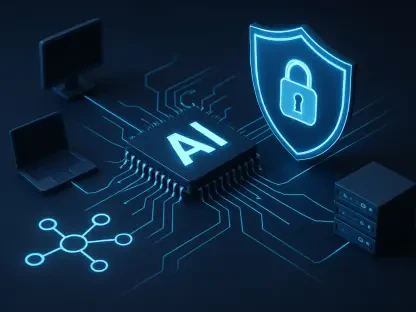Setting the Stage for AI’s Impact on Development
Artificial Intelligence (AI) is reshaping the software development landscape with unprecedented speed, automating tasks that once consumed hours of manual effort, yet a striking statistic emerges from a recent global survey of over 500 developers and project managers: only 9% trust AI-generated code without human oversight. This revelation underscores a critical tension in the market—while AI promises efficiency and innovation, skepticism about its reliability persists. This analysis explores the current state of AI adoption in software development, diving into market trends, data-driven insights, and future projections. It aims to illuminate how this technology is influencing workflows, team dynamics, and skill requirements, offering a roadmap for stakeholders navigating this transformative era.
Market Trends and Data-Driven Insights
Adoption Rates and Efficiency Gains
AI’s integration into software development has reached remarkable levels, with 92% of developers currently utilizing AI-assisted coding tools. These tools, designed to streamline processes like code scaffolding and unit testing, are saving professionals an average of over seven hours per week. This efficiency gain is driving a market shift toward faster delivery cycles, as companies strive to meet escalating demands for rapid software deployment. The widespread adoption reflects a broader industry recognition of AI as a vital component, not merely an optional aid, positioning it as a cornerstone of competitive advantage in a crowded tech landscape.
Trust Barriers and Reliability Challenges
Despite high adoption, trust in AI remains a significant barrier. A mere 9% of developers express confidence in using AI-generated code without human review, while over half categorize it as only “somewhat reliable,” necessitating rigorous validation for accuracy and security. The core issue lies in AI’s limited ability to grasp complex system architectures, often resulting in code that fails to align with broader project goals. This reliability gap highlights a critical market need for enhanced AI capabilities and robust oversight mechanisms, as errors in high-stakes environments can lead to substantial financial and operational risks.
Shifting Roles and Skill Demands
The role of developers is undergoing a profound transformation due to AI’s influence. Data suggests that 65% of senior developers anticipate a pivot from traditional coding to strategic tasks like solution design and system architecture within the next year or two. This shift is creating a demand for “T-shaped engineers”—professionals with broad system knowledge paired with deep expertise in niche areas. As routine tasks become automated, the market is witnessing a growing emphasis on strategic thinking, pushing companies to prioritize upskilling initiatives to prepare their workforce for these evolving responsibilities.
Team Structures and Talent Pipeline Concerns
AI’s impact extends beyond individual roles to reshape team dynamics across the industry. A significant 58% of developers predict leaner, more specialized teams as automation reduces entry-level tasks, streamlining operations but raising alarms about the talent pipeline. With 63% foreseeing new career paths, there is optimism about emerging opportunities, yet the potential shortage of junior roles could hinder the development of future senior engineers. This structural shift presents a market challenge, urging organizations to balance short-term efficiency with long-term talent sustainability through targeted training programs.
Emerging Specializations and Industry Standards
Looking at current trends, AI is becoming an embedded standard in every development phase, from initial design to final testing. Market projections indicate a surge in specialized roles, particularly in AI and machine learning, with 67% of developers identifying this as a growth area, alongside data analytics at 46% and cybersecurity at 45%. This evolution signals a market moving toward hyper-specialization, where AI literacy is no longer a bonus but a baseline requirement. Companies investing in these areas are likely to gain a competitive edge, provided they address the accompanying need for continuous education and skill enhancement.
Future Projections and Market Implications
Technological Advancements on the Horizon
As the market evolves, AI tools are expected to become more adept at handling contextual nuances and system-wide implications over the next few years. Innovations in machine learning and natural language processing will likely refine the accuracy of AI-generated code, though human oversight will remain indispensable for the foreseeable future. This trajectory suggests a market where hybrid workflows—combining AI efficiency with human judgment—will dominate, creating a demand for tools that facilitate seamless collaboration between technology and talent.
Economic and Competitive Dynamics
Economically, the software development market is poised for a divide between companies that embrace AI literacy and those that lag behind. Firms investing in training and robust validation processes are projected to outperform competitors, capitalizing on AI’s productivity boosts while mitigating risks. Additionally, regulatory frameworks may tighten around AI-generated code to address security and ethical concerns, influencing market entry strategies and compliance costs. This dynamic underscores the importance of strategic foresight in leveraging AI as a growth driver without compromising quality or safety.
Workforce Evolution and New Opportunities
The next generation of developers will likely prioritize collaboration with AI, using it as a catalyst for creativity and innovation rather than a complete replacement for human effort. Market forecasts suggest that by 2027, entirely new job categories will emerge, with 59% of developers expecting roles that do not currently exist. This evolution points to a market ripe with opportunity, provided educational systems and corporate training align with these emerging needs. The focus will shift toward fostering adaptability, ensuring professionals can navigate an increasingly AI-driven landscape with confidence.
Reflecting on the Market Landscape
Looking back, the analysis of AI’s role in software development reveals a market at a pivotal juncture, balancing transformative potential with persistent challenges. The limited trust—evidenced by only 9% of developers endorsing unsupervised AI code—highlights the critical need for human oversight that defines much of the discourse. Structural shifts toward leaner teams and specialized roles underscore both opportunities and risks, particularly around talent sustainability. For stakeholders, the path forward involves strategic investments in upskilling, focusing on AI literacy and system thinking to maintain a competitive edge. Additionally, fostering mentorship programs emerges as a vital step to bridge the gap between emerging and experienced talent, ensuring a robust pipeline for the future. As the industry moves forward, embracing AI as a collaborative partner rather than a standalone solution becomes the guiding principle for sustained growth and innovation.









